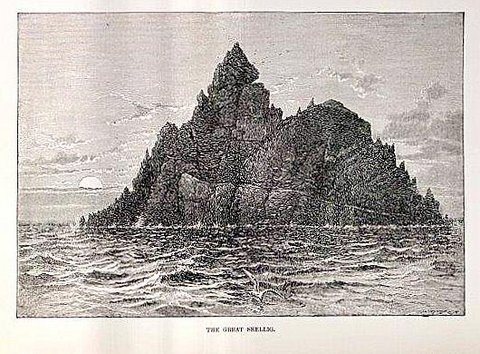Skellig Lists
The custom of composing Skellig lists was a common practice in the nineteenth and well into the twentieth century. Lists were composed, almost always anonymously, targeting unmarried men and women, who though in theory were eligible for marriage had not yet made a match before the start of the Lenten period. The most unlikely of matches were explored in the verses.
In 1751, King George II decreed that Great Britain would switch over from the Julian calendar to the Gregorian calendar - the one we use today. The switch came into effect in September, 1752. The day after September 2nd of that year became September 14th. There were riots in the streets because people believed that the king had stolen 12 days out of their lives. Well into the 20th century, the busiest time for match-making in Ireland began right after Epiphany - January 6th. This was because the Irish had misinterpreted a Church ruling set forth in November, 1563 which prohibited weddings during Lent. The popular reasoning that evolved from this decree was that if you could not marry during Lent, then you had to marry before. Thus, it was taken for granted that Shrovetide was the proper time to marry and Shrove Tuesday - the day before Ash Wednesday - became the most favoured day of all.
There has been a monastic settlement on Skellig Michael since at least the eighth century. Archaeology on the island suggests it could be as early as the fifth or sixth century. The thirteenth century brought a climatic deterioration resulting in colder weather and an increased number of storms. This along with a change in the structure in the Irish church signalled the end of the eremitical community on Skellig Michael. The monks relocated to the mainland around this time although the island still formed an important part of the monastery. The reasoning goes that in theory as the monks, when living on Skellig Michael, had adhered to the Julian rather than the Gregorian calendar, which meant that the Lenten season, began later on Skellig Michael than on the mainland. Theoretically therefore any couple wishing to 'tie the knot' prior to Lent, had the extra days to do so by travelling to the Skelligs.
This Skellig list was collected by Liam Riordan, a pupil at Gleann na gCoileach National School, near Caragh Lake from a S, McBrohan, as part of the National Schools Folklore Collection 1937-1939.
Paddy Downey’s voyage to the Skelligs
This song, written in the vernacular, has a flavour of the tradition of the Skellig lists. It differs in two important areas however. Firstly, it is written in the first person, and secondly, the only person in the song open to ridicule is the protagonist himself. Members of the community of marriageable age who had not married by the start of the Lenten period could find themselves included on a Skellig list’. These humorous lists were composed anonymously and would be recited and sung locally. Bachelors and spinsters could find themselves matched with another unmarried person in the community no matter how absurd the match. As Lent traditionally began ten days later on the Skelligs than on the mainland, the opportunity to get married was in theory extended. The verses were an encouragement to the couples to travel to the Skellig Michael on Shrove Tuesday to wed. It is not known whether anyone availed of this facility. The reference to ‘Pat Flaherty’ in the penultimate and final verse is referring to a brand of whiskey.
Skellig list fragment Dromid late 1940’s
The following versus from this Dromod based Skellig’s List were collected from Patrick (Patcheen) O’Connor R.I.P, Knockroe, Dromod in 2006. He could not recall any other verses. It would be nice to piece the whole song together.
The crowds were chanting, the captain looked ‘round,
and who was appearing ? Paddy ‘Nahown’,
Saying the Cnoc rua women they all left him down,
That’s why I have no Darling.
“Pat” said the captain, “I know it of old,
Was P.D and Mici left you in the cold”.
so the captain ordered “now hurry and throw off your big coat,
or you’re going to get a good dip in the water”.
This Skellig list was donated anonymously to the Binneas Collection. It was in printed form and probably appeared in some other publication yet to be identified. An accompanying note stated that it was collected from a woman near Castlegregory, Co Kerry.
Skellig list fragment Caherciveen circa 1940’s
Across the street lives a tradesman neat,
And he pounds and pounds all day.
He brings fresh life to the young housewife,
For he makes new soles they say.
A Skellig list fragment
………. Bar of the west of a star, All the bachelors passing in flocks
A few had came down and they passed into town, On the way to the famed Skelligs Rock.
………….. ……………. he’s looking around him I’m told,
For a wife to take care of his dairy and keep the long nights from the cold.

